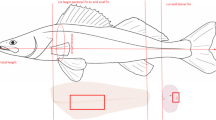Summary
The relative importance of aerobic and anaerobic metabolism during feeding was investigated in the ground skink, Scincella lateralis. Animals were fed crickets of three different sizes relative to body mass (5, 10, and 15% of body mass). Oxygen consumption and lactic acid production of animals during feeding were compared with those of animals at rest and when exercising intensely. Oxygen consumption was higher in feeding and exercising animals than in those at rest. Rates of oxygen consumption of animals consuming prey of 5 and 10% of body mass were not significantly different from each other, but were lower than rates of animals consuming prey of 15% of body mass. Lactic acid concentrations in feeding animals increased with increasing prey size. Concentrations in resting and feeding animals were not different, but those of exercising animals were significantly higher. These data suggest that, despite a positive correlation between prey size and lactic acid concentration, anaerobiosis is relatively unimportant in the support of prey handling for Scincella lateralis. The energetic requirements of feeding in this species are met largely by increased aerobic metabolism.
Similar content being viewed by others
references
Andrews RM, Pough FH, Collazo A, de Queiroz A (1987) The ecological cost of morphological specialization: feeding by a fossorial lizard. Oecologia 73:139–145
Asplund KK (1970) Metabolic scope and body temperature of whiptail lizards (Cnemidophorus). Herpetologica 26:403–411
Bennett AF (1972) The effect of activity on oxygen consumption, oxygen debt, and heart rate in the lizards Varanus gouldii and Sauromalus hispidus. J Comp Physiol 79:259–280
Bennett AF (1980) The metabolic foundation of vertebrate behavior. Biosci 30:452–456
Bennett AF, Dawson WR (1972) Aerobic and anaerobic metabolism during activity in the lizard, Dipsosaurus dorsalis. J Comp Physiol 81:289–299
Bennett AF, Dawson WR, Bartholomew GA (1975) Effects of activity and temperature on aerobic and anaerobic metabolism in the Galapagos marine iguana. J Comp Physiol 100:317–329
Bennett AF, Gleeson TT (1976) Activity metabolism in the lizard Sceloporus occidentalis. Physiol Zool 49:65–76
Bennett AF, Gleeson TT, Gorman GC (1981) Anaerobic metabolism in a lizard (Anolis bonairensis) under natural conditions. Physiol Zool 54:237–241
Bennett AF, Licht P (1972) Anaerobic metabolism during activity in lizards. J Comp Physiol 81:277–288
Bennett AF, Licht P (1973) Relative contributions of anaerobic and aerobic energy production during activity in amphibia. J Comp Physiol 87:351–360
Fitch HS (1956) The University of Kansas Natural History Reservation in 1965. Misc Publ Mus Nat Hist Univ Kansas 42:1–60
Feder ME, Arnold SJ (1982) Anaerobic metabolism and behavior during predatory encounters between snakes (Thamnophis elegans) and salamanders (Plethodon jordani). Oecologia 53:93–97
Gatten RE Jr. (1975) Effects of blood oxygen saturation, lactate, and pH in the turtles, Pseudemys scripta and Terrapene ornata. Physiol Zool 48:24–35
Gleeson TT (1982) Lactate and glycogen metabolism during and after exercise in the lizard Sceloporus occidentalis. J Comp Physiol B 147:79–84
Hutchison VH, Turney LD (1975) Glucose and lactate concentration during activity in the leopard frog, Rana pipiens. J Comp Physiol 99:287–295
Pough, FH (1977) Ontogenetic change in blood oxygen capacity and maximum activity in garter snakes (Thamnophis sirtalis). J Comp Physiol 116:337–345
Pough FH, Andrews RM (1985b) Energy costs of subduing and swallowing prey for a lizard. Ecol 66:1525–1533
Pough FH, Andrews RM (1985b) Use of anaerobic metabolism by free-ranging lizards. Physiol Zool 58:205–213
Ruben JA (1976) Aerobic and anaerobic metabolism during activity in snakes. J Comp Physiol 109:147–157
Seymour RS (1973) Physiological correlates of forced activity and burrowing in the spadefoot toad, Scaphiopus hammondii. Copeia 1973:103–115
Smith KK (1984) The use of the tongue and hyoid apparatus during feeding in lizards (Ctenosaura similis and Tupinambus nigropunctatus). J Zool 202:115–143
Taigen TL, Beuchat CA (1984) Anaerobic threshold of anuran amphibians. Physiol Zool 57:641–647
Vleck D (1987) Measurement of O2 consumption, CO2 production and water vapor production in a closed system. J Appl Physiol 62:2103–2106




